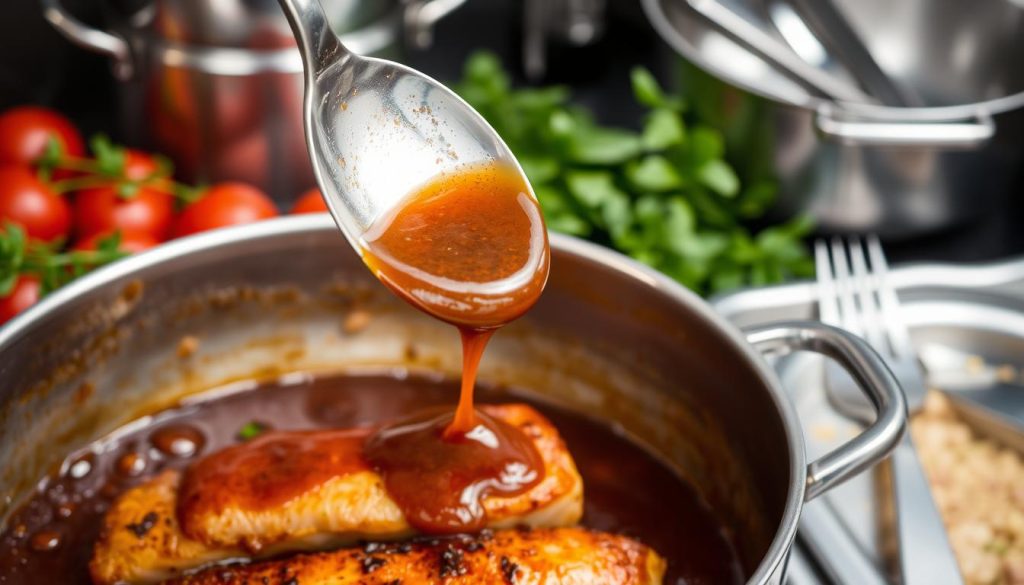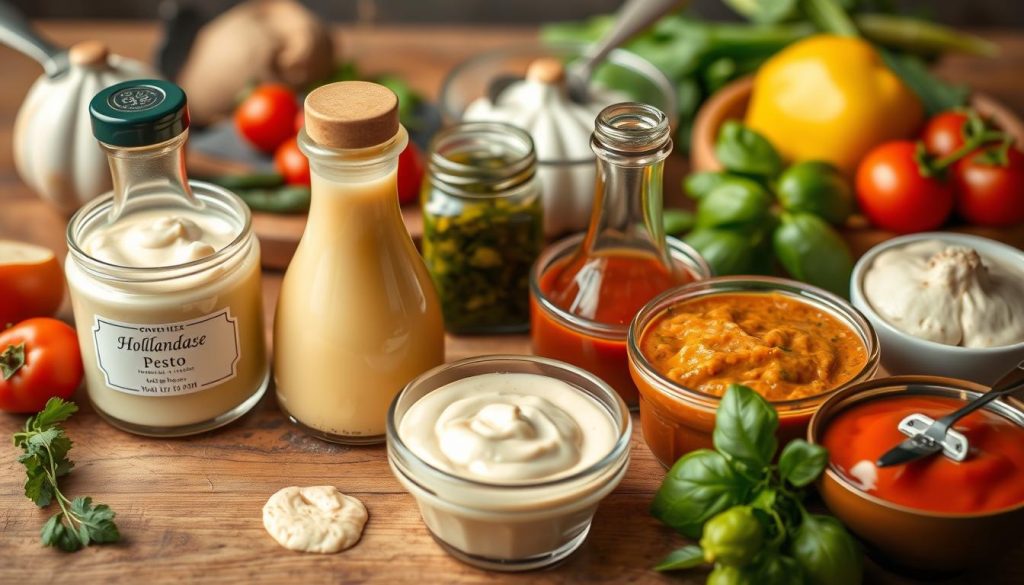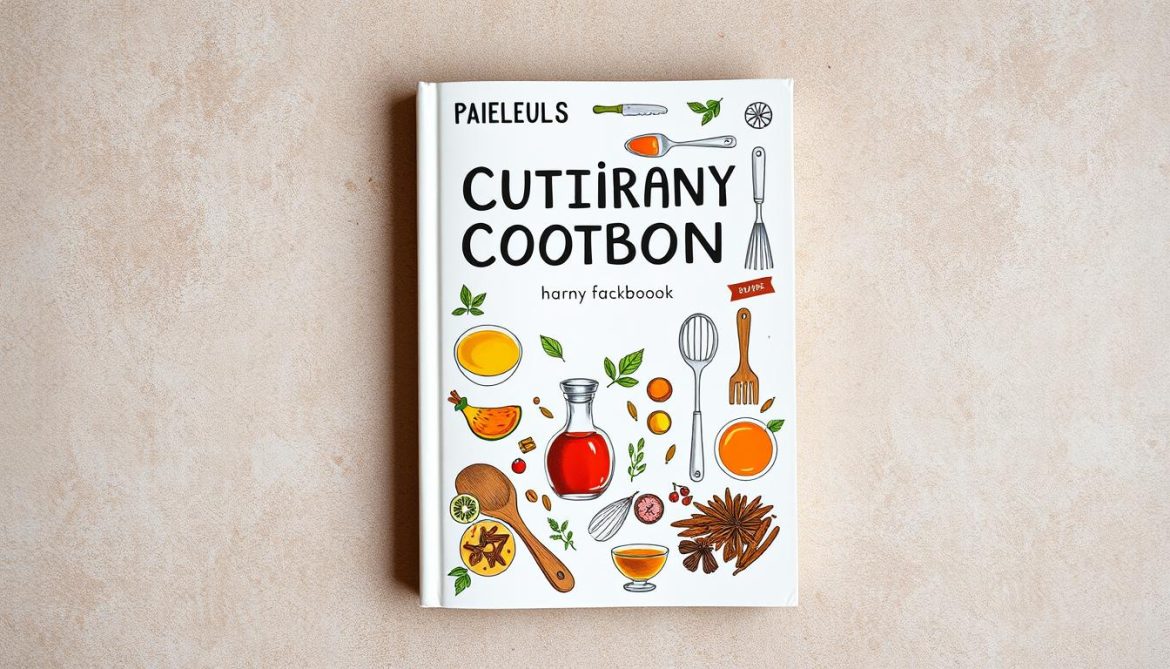Welcome to the ultimate culinary foundations journey! Making delicious sauces is not just for chefs. It’s a skill every home cook can learn. Whether you want to make a simple dinner better or impress guests, knowing basic sauces is key.
Sauces can turn simple ingredients into amazing meals. They range from creamy classics to zesty new flavors. Learning to make sauces is like learning a universal language of taste.
In this guide, I’ll teach you all about making tasty sauces. You’ll learn pro chef techniques, essential ingredients, and how to make sauces that wow. Get ready to explore a world of culinary creativity!
Cooking is an adventure, and sauces are your best friends. We’ll cover easy, fun, and delicious sauce-making techniques. From French mother sauces to quick pan sauces, you’ll become a pro in no time. Let’s start this flavorful journey together! 🥄🔥
Understanding the Foundations of Classic Sauce Making
Exploring classic sauce making is like opening a culinary treasure chest. It starts with mastering the art of making smooth, tasty sauces. These sauces can turn any simple meal into a gourmet dish.
Let’s dive into the essential elements for becoming a sauce-making expert!
Essential Equipment for Sauce Preparation
For sauce making, you’ll need:
- Heavy-bottomed saucepans
- Whisk
- Fine-mesh strainer
- Wooden spoon
- Measuring cups and spoons
“The right tools can make the difference between a good sauce and a great sauce!” – Professional Chef
Basic Ingredients Every Kitchen Needs
Stock your pantry with these basic ingredients for classic sauce making:
- High-quality butter
- Fresh herbs
- Good olive oil
- Flour
- Stock or broth
Sauce Making Techniques and Terms
Learning a few key techniques will boost your sauce skills. Reduction concentrates flavors by simmering. Emulsification blends ingredients that usually don’t mix, making sauces smooth.
Pro tip: Keep your heat low and stir constantly to avoid burning. Patience is key to perfect sauces!
The Five Mother Sauces of French Cuisine
Let’s explore the world of classic sauce making! The five mother sauces are the key to turning simple dishes into amazing culinary experiences. They come from French cuisine and are the foundation of professional cooking.
Each mother sauce has its own flavor and cooking method. Chefs have used them for generations. They are like the primary colors of cooking, from which many variations can be made!
- Béchamel: A creamy white sauce made from milk, butter, and flour
- Velouté: A light sauce created with white stock and roux
- Espagnole: A rich brown sauce based on beef or veal stock
- Hollandaise: A luxurious butter-based emulsion
- Tomato: A vibrant sauce made from fresh tomatoes and herbs
“Master these mother sauces, and you’ll unlock a world of culinary creativity!” – Auguste Escoffier
Learning these sauces opens up endless possibilities in the kitchen. Each sauce can be changed with different ingredients, creating hundreds of tasty variations. These can make any dish go from simple to spectacular.
Whether you’re cooking at home or dreaming of being a chef, mastering these mother sauces will change your cooking. It will give you the confidence to try new flavors like never before!
Mastering Béchamel: The White Mother Sauce
Béchamel is a creamy sauce that makes many dishes special. It’s a basic sauce recipe that every home cook should know.
Exploring béchamel, a smooth sauce, is exciting. It’s great for adding flavor to many recipes. To make perfect béchamel, you need to know a few key steps.
Perfect Consistency Tips
- Always use equal parts butter and flour for the roux base
- Whisk continuously to prevent lumps from forming
- Heat milk gradually to ensure smooth incorporation
- Maintain medium-low heat throughout cooking
Common Béchamel Variations
| Variation | Key Ingredients | Best Used For |
|---|---|---|
| Mornay Sauce | Cheese added to basic béchamel | Gratins and mac & cheese |
| Soubise Sauce | Puréed onions mixed in | Vegetable dishes |
| Mustard Béchamel | Dijon mustard blended | Meat and fish dishes |
Troubleshooting Béchamel Problems
Lumpy sauce stressing you out? Don’t panic! The key to smooth béchamel is patience and the right technique. If your sauce has lumps, just use a hand mixer or strain it through a fine-mesh sieve to make it smooth again.
“Cooking is about passion, so it may look slightly temperamental in the process.” – Gordon Ramsay
With practice, you’ll turn this simple white sauce into a masterpiece. It will make any dish special. Your confidence in the kitchen will grow as you master this versatile sauce!
Creating Rich and Versatile Espagnole Sauce
Explore the world of culinary foundations with Espagnole sauce. It’s a powerful flavor enhancer that turns simple dishes into amazing culinary experiences. This brown sauce is one of the five classic mother sauces of French cuisine. It adds a depth of flavor that can make any recipe better.
Making the perfect Espagnole sauce needs precision and passion. The main ingredients are:
- Beef or veal stock
- Roasted bones and vegetables
- Tomato paste
- Brown roux
“A great sauce is the soul of any dish – it speaks without words and connects flavors in magical ways.” – Classic Culinary Wisdom
To make Espagnole sauce, follow these steps:
- Create a rich brown roux by carefully browning flour and butter
- Add dark stock made from roasted beef or veal bones
- Incorporate tomato paste for depth and color
- Simmer and reduce to concentrate flavors
Professional chefs love Espagnole sauce for its versatility. It’s a base for other classic sauces like demi-glace and bordelaise. Its complex flavor makes it a key part of advanced cooking techniques.
Pro tip: Patience is crucial when developing the rich, mahogany color that defines an authentic Espagnole sauce!
Best Basic Sauces for Everyday Cooking
Let’s explore the world of tasty basic sauces that make meals special. These versatile condiments are key to making your cooking better with little effort.
Quick Preparation Methods
Making tasty sauces doesn’t have to be hard. I’ll show you quick ways to make sauces that save time but don’t lose flavor:
- Blend fresh herbs with olive oil for an instant herb sauce
- Whisk together pantry staples for quick vinaigrettes
- Use Greek yogurt as a base for creamy dressings
- Combine soy sauce, honey, and garlic for a rapid Asian-inspired sauce
“Great sauces are the secret weapon of home cooking!” – Professional Chef’s Wisdom
Storage and Reheating Guidelines
Storing your sauces right keeps them fresh and tasty. Here are some tips:
- Store sauces in airtight glass containers
- Refrigerate immediately after preparing
- Use within 3-5 days for optimal freshness
- Reheat gently on low heat to prevent separation
With these easy tips, you’ll be a sauce expert in no time! Your meals will always be exciting.
Perfecting Homemade Tomato-Based Sauces
Dive into the vibrant world of sauce recipes that transform simple tomatoes into culinary magic! Creating flavorful accompaniments starts with understanding the core cooking fundamentals of tomato-based sauces.
Let’s explore the art of crafting incredible tomato sauces that will elevate your cooking game. The secret lies in selecting the right ingredients and mastering a few key techniques.
- Choose ripe, fresh tomatoes for maximum flavor
- Understand the importance of slow simmering
- Learn to balance acid and sweetness
“A great sauce is the heart of any memorable dish!” – Professional Chef’s Wisdom
Different tomato varieties bring unique characteristics to your sauce. San Marzano tomatoes offer exceptional sweetness, while Roma tomatoes provide a robust texture perfect for cooking.
| Tomato Type | Flavor Profile | Best Used For |
|---|---|---|
| San Marzano | Sweet, Low Acid | Pasta Sauces |
| Roma | Meaty, Rich | Marinara |
| Beefsteak | Juicy, Mild | Fresh Sauces |
Pro tip: Roasting tomatoes before making your sauce intensifies their natural sweetness and adds depth to your culinary creations. Experiment with herbs like basil, oregano, and thyme to create signature sauce recipes that will impress everyone at the dinner table!
Essential Asian Sauce Foundations
Explore the world of Asian flavor enhancers that will change your cooking! Asian sauces are the magic that turns simple dishes into amazing ones. They add depth, complexity, and excitement to your cooking.
Asian cuisine is all about flavors that mix beautifully. The best basic sauces from this area are more than just toppings. They are a form of culinary art that perfectly balances taste and texture.
Key Asian Ingredients That Make Magic Happen
- Soy Sauce: The ultimate flavor enhancer
- Miso Paste: Fermented umami powerhouse
- Fish Sauce: Intense and complex liquid gold
- Rice Vinegar: Bright and tangy base for many sauces
- Sesame Oil: Nutty and aromatic finishing touch
Balancing Sweet, Sour, and Umami Flavors
Mastering Asian sauces is about finding the right flavor mix. It’s all about balancing sweet, sour, and umami tastes.
| Flavor | Ingredients | Typical Use |
|---|---|---|
| Sweet | Honey, Sugar, Mirin | Rounding out sharp flavors |
| Sour | Rice Vinegar, Lime Juice | Adding brightness and contrast |
| Umami | Soy Sauce, Miso, Mushrooms | Creating depth and richness |
“Asian sauces are like a symphony – each ingredient plays a crucial role in creating the perfect flavor harmony.” – Chef David Chang
Pro tip: Start with small amounts and build your sauce gradually. The magic is in the balance, not overwhelming your dish with any single flavor. Experiment, taste, and adjust – that’s the true art of creating amazing Asian sauces!
Crafting Creamy Pasta Sauces
Pasta lovers, get ready to turn your kitchen into a sauce paradise! Making delicious sauces is an art that makes simple noodles into amazing meals. The secret to great pasta dishes is mastering some of the best basic sauces.
Let’s explore creamy pasta sauces that will make your taste buds dance. I’ll share my favorite techniques for making flavorful sauces that will take your pasta game to the next level.
Essential Creamy Sauce Ingredients
- Heavy cream
- Parmesan cheese
- Butter
- Garlic
- Fresh herbs
Pro tip: The key to a perfect creamy sauce is patience and constant stirring. Low and slow is the magic formula for achieving that velvety smooth texture everyone craves!
Classic Creamy Pasta Sauce Variations
| Sauce Type | Key Ingredients | Flavor Profile |
|---|---|---|
| Alfredo | Cream, butter, parmesan | Rich and decadent |
| Carbonara | Eggs, pecorino, black pepper | Silky and peppery |
| Vodka Sauce | Tomatoes, cream, vodka | Tangy and smooth |
“Cooking is love made visible” – Anonymous Chef
Don’t be intimidated by creamy sauces! With a few simple techniques, you’ll be whipping up restaurant-quality pasta dishes in no time. The magic is all in understanding how ingredients interact and learning to balance flavors.
Quick Sauce-Making Tips
- Always use room temperature ingredients
- Stir continuously to prevent burning
- Season gradually and taste as you go
- Use high-quality cheese for maximum flavor
Whether you’re a beginner or a seasoned home cook, these sauce recipes will transform your pasta nights. Remember, great cooking is about passion, practice, and a little bit of culinary magic! 🍝👨🍳
Quick Pan Sauces for Meat Dishes
Every home cook knows the magic of those delicious brown bits stuck to the bottom of a pan after searing meat. These flavorful remnants are the secret weapon for creating incredibly rich and tasty pan sauces. They can transform an ordinary meal into a restaurant-worthy experience.

Pan sauces are the ultimate cooking fundamentals that elevate meat dishes from simple to spectacular. With just a few basic techniques, you can turn those caramelized bits into versatile condiments. They will impress your family and friends.
Deglazing Techniques
Deglazing is the key to unlocking intense flavor in your pan sauces. Here’s how to do it like a pro:
- Remove meat from the pan after cooking
- Keep the delicious browned bits (called fond)
- Pour in liquid to release those flavor-packed particles
Flavor Enhancement Methods
Transform your pan sauces with these flavor enhancers:
- Use wine or broth for deglazing
- Add fresh herbs for depth
- Incorporate butter for richness
- Finish with a splash of cream
“The secret to an incredible pan sauce is respecting those caramelized bits and building layers of flavor.” – Professional Chef
| Liquid | Flavor Profile | Best Paired With |
|---|---|---|
| Red Wine | Rich, Complex | Beef, Lamb |
| White Wine | Light, Crisp | Chicken, Fish |
| Chicken Stock | Savory, Neutral | Most Meats |
With these techniques, you’ll create pan sauces that are bursting with flavor and restaurant-quality elegance. Practice makes perfect, so don’t be afraid to experiment!
Versatile Herb-Based Sauces
Herb-based sauces are a secret ingredient that makes any dish special. They add fresh, vibrant flavors to your cooking. This lets you try new tastes and make your meals better.
Let’s look at some top herb-based sauces:
- Classic Pesto: A mix of basil, pine nuts, garlic, olive oil, and parmesan
- Chimichurri: An Argentinian sauce with parsley, garlic, vinegar, and olive oil
- Salsa Verde: A zesty green sauce with parsley, cilantro, and mint
“Herbs are the magic wand of culinary creativity – they can turn simple ingredients into extraordinary dishes!”
Making herb-based sauces is simple. Just use fresh, quality ingredients. Also, know how herbs work together.
| Herb | Flavor Profile | Best Pairings |
|---|---|---|
| Basil | Sweet, peppery | Tomato dishes, pasta, chicken |
| Cilantro | Bright, citrusy | Mexican, Asian cuisines, fish |
| Parsley | Fresh, mild | Grilled meats, seafood, salads |
Keeping your sauces fresh is key. Pro tip: Store them in airtight containers in the fridge. This keeps their taste and nutrients alive.
Healthy Sauce Alternatives and Substitutions
Making tasty sauce recipes doesn’t have to hurt your health goals. As a home cook, I’ve found amazing ways to make traditional sauces healthier. These sauces are full of flavor and good for you.
Healthy eating is about choosing the right ingredients. This keeps your food tasty and nutritious. Here are some sauce alternatives that will change your cooking!
Low-Fat Sauce Options
It’s simple to make low-fat sauces. Here are some great swaps:
- Greek yogurt instead of heavy cream
- Pureed vegetables as thickening agents
- Broth-based sauces replacing butter-rich versions
Dairy-Free Sauce Variations
Even with dietary limits, you don’t have to eat bland food. Try these dairy-free sauce options:
| Base Ingredient | Sauce Type | Flavor Profile |
|---|---|---|
| Coconut Milk | Creamy Curry Sauce | Rich, Exotic |
| Cashew Cream | Alfredo Alternative | Smooth, Neutral |
| Nutritional Yeast | Cheese-Like Sauce | Umami, Tangy |
“Healthy cooking is an art of transforming simple ingredients into extraordinary flavor experiences!” – Chef’s Secret
With these new sauce recipes, you’ll make delicious meals that are good for you. Try new things, have fun, and enjoy your cooking journey!
Sauce Pairing Guide for Different Cuisines
Learning to pair sauces can turn simple meals into amazing dishes. The right sauces can make a big difference, adding depth and excitement to your food.

Knowing which sauces go best with different cuisines is key. It’s about finding the right balance of flavors and understanding cultural tastes. Let’s dive into some great sauce pairings that will take your cooking to the next level!
- Italian Cuisine: Rich tomato-based sauces paired with herbs like basil and oregano
- Asian Fusion: Soy-based glazes with hints of ginger and garlic
- French Classics: Delicate cream sauces complementing subtle protein flavors
- Mexican Dishes: Spicy salsa and tangy verde sauces
Sauce pairing is more than just taste. It’s about creating a perfect dining experience.
| Cuisine | Recommended Sauce | Flavor Profile |
|---|---|---|
| Mediterranean | Tzatziki | Creamy, Tangy, Herbal |
| Thai | Peanut Sauce | Sweet, Spicy, Nutty |
| Indian | Mint Chutney | Cool, Zesty, Refreshing |
“The right sauce can transport a dish from ordinary to extraordinary!” – Culinary Experts
Pro tip: Always taste your sauce alone before mixing it with your dish. This lets you see how it tastes on its own and how it might mix with other flavors.
Storage Tips and Make-Ahead Strategies
Exploring cooking basics means learning about sauce making and how to keep them fresh. With the right tools, you can keep your homemade sauces good for longer. This way, you’ll always have tasty options ready when you need them.
I always use glass containers with tight lids for storing sauces. Mason jars or special sauce containers work great. They handle temperature changes well. Plus, labeling each container with the sauce type and date helps avoid unknown ingredients in your fridge.
Freezing is a big help for sauces. Most cream and tomato sauces freeze well for up to three months. Just remember to leave some space at the top of the container for expansion. Thaw them slowly in the fridge overnight for the best taste and texture.
Not all sauces are created equal when it comes to storage. Herb-based sauces usually last 3-5 days, while meat-based ones can last a week. Use good airtight containers. And always trust your nose – if it smells bad, it’s time to throw it away!
